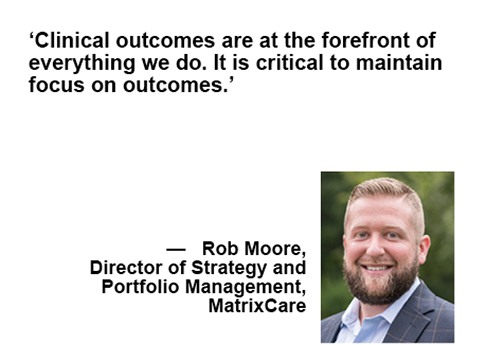Call it the ripple effect. A great clinical team produces positive resident outcomes. Positive outcomes lead to satisfied residents and families, which leads to a good reputation in the wider community. That leads to more referrals, higher occupancies and organizational success.
“Clinical outcomes are at the forefront of everything we do,” says Rob Moore, director of strategy and portfolio management at MatrixCare, a provider of senior living software solutions. “It is critical to maintain focus on outcomes.”
The best way to ensure good resident outcomes? Give the clinical team a supportive and engaging work environment.
That’s the big takeaway from Moore and several other veteran senior living executives. They recently weighed in on how to build a best-in-class clinical team amid a workforce shortage, creating a ripple effect that boosts the bottom line and streamlines operational efficiencies.
Here are their top five strategies:

RKL
1. Invest in the clinical team. Competitive wages and benefits are a must. But the investment goes well beyond compensation packages. Give the clinical team the resources and tools it needs to serve residents. “The clinical team can be the boots on the ground,” says Stephanie Kessler, partner in the senior living consulting group at advisory firm RKL. “They interact day in and day out with residents and families.”
Mentorship and professional development programs help reduce turnover, according to Tina Doerr, product manager at MatrixCare. But both programs require an investment of time and money.

Mental health support is also critical, especially in the aftermath of the pandemic, adds Doerr. Onboarding, educational and mentoring programs should address the importance of emotional resilience. It might also be good to design spaces where the staff can find some alone time to disconnect. Rethink the break room. “Create more personal environments,” says Doerr.
Provide the right tools, including easy-to-use software, that eliminates repetitive tasks such as having to make multiple entries of clinical data.
Drill down, says Moore. How many clicks does it take to accomplish a task? The fewer hours the staff spends logging tasks, the more time they have to interact with and care for residents.
2. Make education more engaging. The director of clinical education plays a big role in staff engagement. Continuing education is important, so try to get the staff involved in the process, according to More. For example, instead of distributing packets of information on policies for the staff to read, bring the staff together for an hour to collaborate on the topic as a group. “Get creative with training,” says Moore. Also, connect workers in rural areas with professional organizations to act as a resource.

Claiborne Senior Living
3. Focus on communication skills. Though the workforce shortage has eased a bit, staffing is still a big issue, notes Tim Dunne, CEO at Claiborne Senior Living, an owner and operator of 11 communities. “There’s no silver bullet,” admits Dunne. He uses a number of different strategies to recruit and retain staff. But this year, he’s focused on communication skills to boost clinical team performance. “The front-line staff is the first line of defense when a family or resident is dissatisfied,” he says. Staff training and messaging set the stage for clear and concise communication.
Good communication not only improves resident and family satisfaction but also staff satisfaction because they feel better equipped to handle difficult situations. Communications training, combined with other retention strategies, has reduced turnover at Claiborne by 50 percent this year. “We tweak programs as we go along,” says Dunne.
4. Improve working conditions. Consider flexible scheduling. Innovative technology allows workers to log on and pick up a shift or work in another location. “Look for areas where you can make improvements that have long-term impact,” says Doerr.
Another suggestion: Find out why workers quit by conducting an exit interview. Did they have an issue with their supervisor or did they not like their shift? Maybe they didn’t understand the job? Better yet, have ongoing conversations with them while they’re still employed. “It’s amazing what you’ll find out from employees,” says Kessler. She also asks staff what they like and personalizes rewards according to what motivates each person, whether it’s a gift card for coffee or a day off.
5. Hold staff accountable. It’s important to hold staff accountable even in a tight labor market when it’s easy to overlook violations in order to cover a shift. Accountability fosters a culture where responsibility and commitment are valued, notes Kessler. Those who aren’t held accountable won’t change their behavior — meanwhile, those who do follow the rules will wonder why nothing is being done about the situation.
“Set expectations upfront,” says Doerr. “Don’t settle for someone who cannot meet the job’s criteria.” But she adds, “Keep it fun. Keep them motivated. Keep everyone moving forward to improve outcomes so the bottom line can grow.”
Your clinical team can play a crucial role when it comes to improving resident outcomes. That’s why it’s important to leverage the right tools and approaches when it comes to investing in and building your clinical team. Employee training, clear communication and rewards are logical points of contact to enhance workplace experiences and provide support. Saving employees time through technology (especially technology that eliminates repetitive or overly complicated tasks) plus efforts to make staff feel appreciated can be critical waypoints that lead to a positive cycle of improvements. These improvements often lead to streamlined processes and the creation of supportive environments as employees adopt procedures and best practices that help improve their work and the lives of residents.
— By Jane Adler. This sponsored content was written in conjunction with MatrixCare, a content partner of Seniors Housing Business.
Learn more about MatrixCare technology and the impact it can have for your clinical team.

